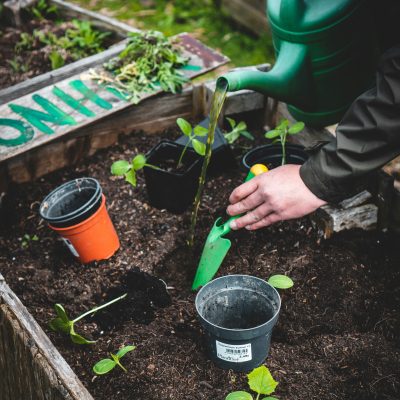Article
Hayley’s project was born out of a desire to address two interconnected challenges: the mental health struggles faced by foster youth and the widespread sense of disempowerment many young people feel in the face of climate change. Foster youth often deal with trauma, instability, and limited access to safe, healing environments. “They also tend to be disconnected from nature, which can play a big role in emotional healing a building a sense of calm and stability,” Hayley explained.
At the same time, according to Hayley, young people increasingly express anxiety about climate change but often feel powerless or unsure of how to take meaningful action, particularly if they lack experience with nature or sustainability practices. Hayley, reflecting on her own journey of discovering the healing power of gardening during a difficult period in her life, envisioned a solution that could address both needs.
The result was a trauma-informed gardening program that provided foster youth with a safe space to reconnect: with the earth, with themselves, and with each other. Through hands-on activities, reflection, and group discussions, the workshops helped youth build emotional resilience while also learning about environmental stewardship.
Project Development
To bring her idea to life, Hayley began by building partnerships with community-based organizations including the Clark County Food Bank, iUrban Teen, and the Mullen-Polk Foundation. Their support gave her both the confidence and the logistical backing needed to launch a pilot program.
This project blends environmental education with emotional reflection.
She then immersed herself in research, particularly focusing on youth gardening programs and trauma-informed teaching practices. Drawing on resources from Cornell Cooperative Extension, she developed a four-week curriculum structured around key themes such as soil, planting, and composting. The program blended environmental education with emotional reflection, incorporating mindfulness activities and journaling to support healing.
The pilot was designed to be both structured and adaptable, offering a supportive space for youth to grow plants and begin their own healing journeys.
Project Implementation and Lessons Learned
Over the course of four weeks, a small group of foster youth gathered in a local garden to engage in the pilot sessions. Week by week, they planted seeds, tended to soil, and began to open up – both to the natural world and to one another. Hayley adjusted the sessions based on participants’ feedback, ensuring that the workshops stayed flexible and youth-centered.
The gardening project provided space for trust, connection, and emotional release through nature.
One particularly touching moment came during a session on planting dahlias. A participant named Levi brought seeds he had saved from his grandmother’s garden – ones he had never planted before. As he carefully placed them in the soil, he began sharing personal stories from his life in foster care. He later told Hayley he hadn’t felt that calm in a long time. That moment captured the heart of the project: providing space for trust, connection, and emotional release through nature.
Of course, there were challenges too. Some youth had difficulty focusing or exhibited trauma-related behaviors. Hayley learned to respond with patience and empathy, understanding that consistency and calm could go a long way in building trust. She also discovered that the quiet, simple moments like watering plants or sitting in the sun often led to the most meaningful connections.
Her advice to others is to stay flexible, focus on relationship-building, and don’t worry about being perfect. “Just be present, kind, and consistent,” she says.
Next Steps
The success of the pilot has opened the door for the program to continue and grow. Hayley worked with the Clark County Food Bank to develop transition documents, including the full curriculum, feedback summaries, and recommendations for future sessions. The Food Bank plans to continue the program and may expand it to reach more youth.
Healing doesn’t have to be complicated.
Hayley also shared the curriculum with partners at iUrban Teen and the Mullen-Polk Foundation, encouraging them to adapt it for their own programs. She hopes others will take the initiative to launch similar efforts in their communities.
There are many ways for others to get involved: volunteering at local community gardens, donating tools or seeds, or simply showing up to offer support. Above all, Hayley’s project proves that healing doesn’t have to be complicated; it can begin with something as small and hopeful as planting a seed.
Updated July 2025




